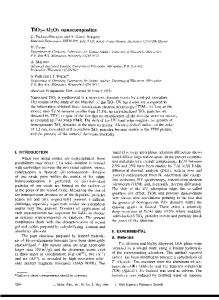Effects of TiO 2 on the microstructure and mechanical properties of Al 2 O 3 /ZrO 2 composites
- PDF / 401,958 Bytes
- 7 Pages / 612 x 792 pts (letter) Page_size
- 39 Downloads / 446 Views
MATERIALS RESEARCH
Welcome
Comments
Help
Effects of TiO2 on the microstructure and mechanical properties of Al2 O3yZrO2 composites Chii-Shyang Hwanga) and Yu-Jing Chang Department of Materials Science and Engineering, National Cheng-Kung University, Tainan, Taiwan, Republic of China (Received 16 August 1995; accepted 18 December 1995)
The microstructure and mechanical properties of hot-pressed zirconia-toughened alumina (ZTA), fabricated from the ZTA powders containing (Zr, Ti)O2 in Ar gas were investigated. In hot-pressed ZTA, the presence of Ti concentration in the grains of Al2 O3 or (Zr, Ti)O2 was analyzed by the energy dispersive spectroscopy (EDS) attached to the analytical electron microscope (AEM) apparatus. Experimental results showed that some Ti ions diffused to the grain boundary and into the Al2 O3 grains, thereby enhancing the densification of hot-pressed ZTA. It was possible to retain tetragonal ZrO2 at room temperature in the ZTA specimens containing >5.5 mol % TiO2 and hot pressed at 1350 ±C for 1 h. The bending strength and toughness of hot-pressed ZTA were enhanced by the addition of TiO2 .
I. INTRODUCTION
Zirconia-toughened alumina (ZTA) ceramics have many applications where high wear resistance and mechanical strength are required.1,2 The improvements of the microstructure and mechanical properties of ZTA ceramics have been reported. For the uniform dispersion of ZrO2 into Al2 O3 matrix, sol-gel methods have been employed, using a variety of starting materials, e.g., Al- and Zr-alkoxide,3,4 and Al2 O3 - and Zr-alkoxide.5 To improve the sintering and microstructure of ZTA, the addition of TiO2 has been reported to be effective.6,7 Additionally, for the fabrication of stronger and tougher ZTA composites, hot isostatic pressing8,9 or hot-pressing10 process has also been used. The authors prepared ZTA powders by the hydrolysis of a mixture containing alumina powder and Zrand Ti-alkoxides. Through the hydrolysis, drying, and calcination, the zirconia and titania gels condensed into ultrafine particles and were uniformly deposited onto the surface of alumina powders.11 It was shown that the ZTA powder contained Zr–O –Ti bonding; i.e., ZrO2 and TiO2 formed a solid solution of (Zr, Ti)O2 . TiO2 additive had a significant effect on the coalescence of ZrO2 particles and on the formation of a crystalline ZrO2 phase.12 The retention of t-ZrO2 in the ZTA powders was increased, and the sinterability of ZTA compact in air was enhanced with increasing TiO2 content in the range 0–5.5 mol %. The grain sizes of the Al2 O3 and ZrO2 particles in the ZTA sintered body were also increased with increasing TiO2 content.13 Consequently, the mechanical properties of ZTA sintered bodies were not readily improved.14 a)
Address all correspondence to this author. J. Mater. Res., Vol. 11, No. 6, Jun 1996
http://journals.cambridge.org
Downloaded: 12 Mar 2015
In order to decrease the grain size and to enhance the mechanical properties of ZTA, the microstructure and mechanical properties of ZTA composites fabricated b
Data Loading...











